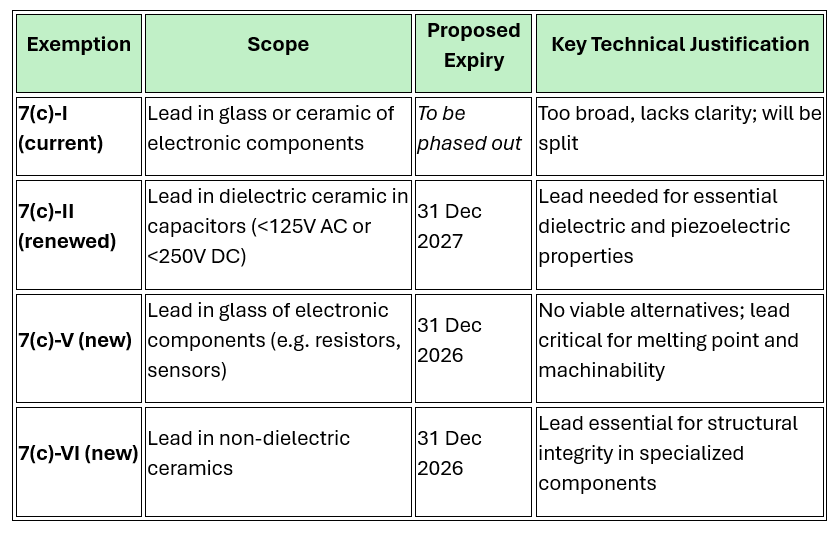The European Commission has proposed a delegated directive amending Annex III of Directive 2011/65/EU (RoHS Directive), specifically targeting the use of lead in glass and ceramic materials in electrical and electronic equipment (EEE).
The draft restructures existing exemptions, introduces clearer categories, and extends certain exemptions with new expiry dates.
Background: RoHS and Substance Exemptions
The RoHS Directive limits the use of hazardous substances in EEE, including lead, mercury, cadmium, hexavalent chromium, and flame retardants PBB and PBDE.
Exemptions may be granted when:
• Substitution is technically or scientifically impracticable, or
• The negative effects of substitution outweigh the benefits to human health or the environment.
Exemptions are listed in Annex III (for general EEE) and Annex IV (for medical and monitoring equipment) and are subject to periodic review.
What’s Changing in the Draft Directive
The proposal restructures and replaces the broad exemption 7(c)-I with more specific sub-categories, each with its own scope and expiry date:

|
Why the Update Matters?
⚙️ Technical Dependency
Lead remains critical in ceramic capacitors, glass formulations, and specialty ceramics, especially in high-reliability sectors such as:
• Medical equipment
• Aerospace systems
• Telecommunications infrastructure
📉 Market Impact
• Immediate lead replacement is technically unfeasible for many applications.
• Staggered expiry dates give manufacturers time for R&D and supply chain adaptation.
⚖️ Regulatory Harmonization
• Member States must transpose the new directive within six months of entry into force.
• Provides legal clarity for manufacturers navigating material compliance.
What Stakeholders Should Do Next
🏭 For Manufacturers
• Review supply chains and materials lists for affected components.
• Prepare for possible redesigns or material substitutions.
• Plan for 2026–2027 phase-out deadlines if exemptions are not extended.
🏛️ For Regulators
• Ensure consistent enforcement across Member States.
• Monitor industry progress and prepare for future re-evaluations.
👥 For Consumers and Markets
• Expect short-term cost fluctuations due to material changes.• May accelerate innovation in lead-free ceramics and glass.
Next Steps and Further Actions
1. Track EU legislative progress — the final directive may still change.
2. Participate in public consultations — technical feedback can impact exemption renewal.
3. Plan transition strategies — especially for components affected by 2026 expirations.
4. Stay alert to future reviews — exemptions are re-evaluated based on technological advancements.
Reference: EUR-Lex – Ares(2025)216368 – EN – EU Law Portal
Reach out to our regulation experts on chemical and product regulatory compliances



